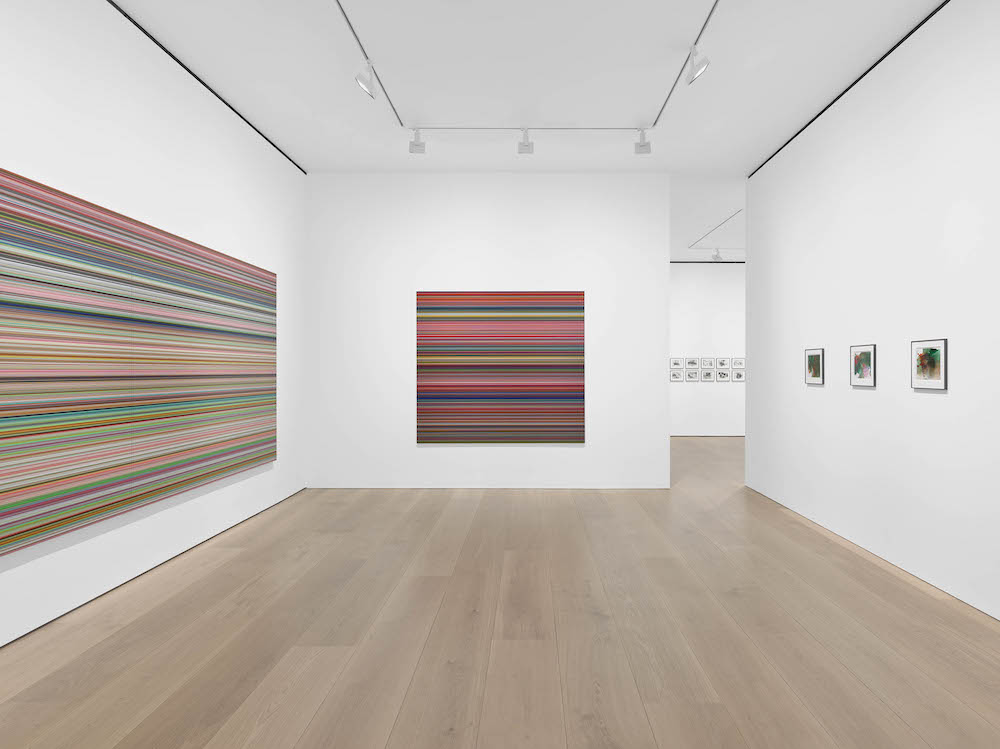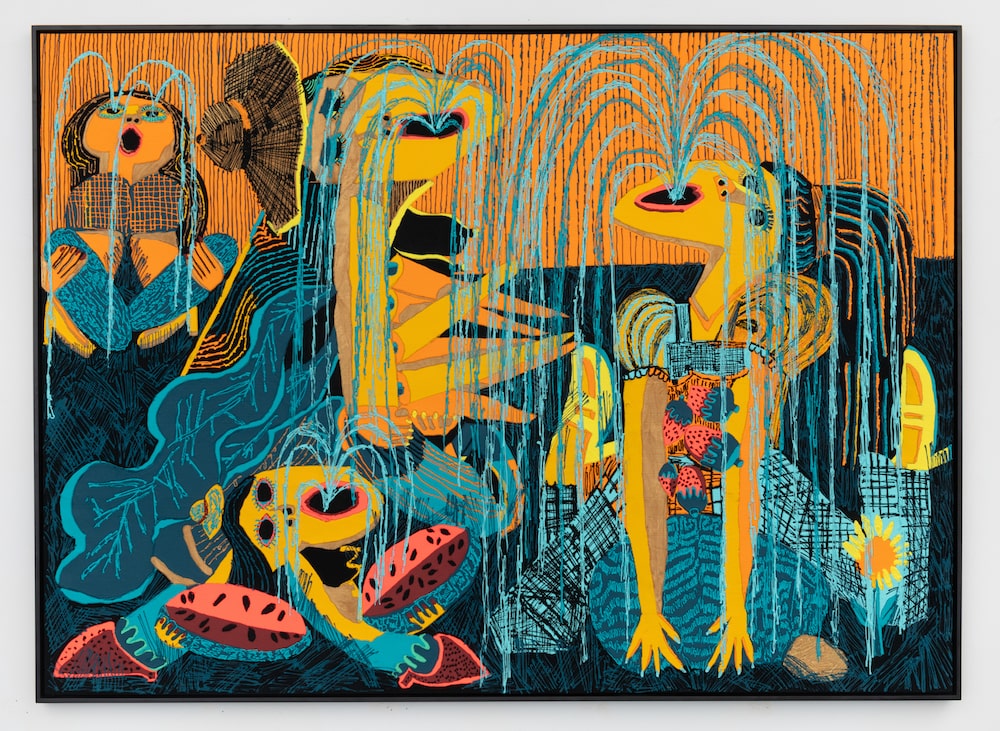Marcel Dzama, whose drawings at once appear full of youthful innocence while detailing a mature, intricate fiction concerned with surrealism, has gained recognition over the past decade for being one of the most earnest and interesting artists around; cultivating much appraisal with his visual storytelling ability through vast tales of illustration that depict self-created characters in a grandiose world of their own.
“Puppets, Pawns, and Prophets”, his first London exhibition with David Zwirner that ran earlier this month, presented a telling insight into his unique world, offering the chance to discover his wide artistic discipline spanning across film, performance, sculpture, and of course, drawing. Speaking to Marcel ahead of the opening, we discussed how real, often tragic events dramatically affect his practice, and how at this mid-point in his life, reflection causes one’s imagination to work in very different, yet still, fascinating ways.
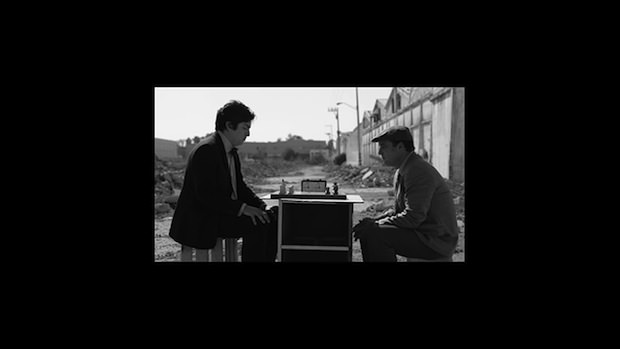
Video on monitor, 13:55 min, black and white, sound
Whitewall: The title of your first London show with David Zwirner, Pawns, Puppets, and Prophets, is profound; can you explain the meaning of this title?
Marcel Dzama: The name is inspired by all things chess related, and a few of the drawings are based on the hundred year anniversary of Nude Descending a Staircase, from the 1913 Armory show, that was revolutionary and sort of began contemporary art in America, changing everything in the art world. I like the idea of taking over this hierarchy system with pawns, puppets, and prophets in charge. It’s that feeling that everything can change. In my mind it makes sense.
WW: With adult themes in mind, are you trying to represent your own resolution to what’s happening in the real world?
MD: Yes, all of the time. And much of it is within the moment. Like when I’m drawing, I can be disturbed by the news and it may change the work entirely. For instance, in one of my drawings I had this weird gangster figure, and I only drew this gangster figure because someone mentioned I draw gangsters, and I thought that I hadn’t drawn a gangster in a long time. But after hearing the news about this tragedy, where a crazy guy went into the Batman film and started shooting, the mood in my drawing changed drastically. I listen to NPR constantly when I’m drawing, so current events affect where I’m going.
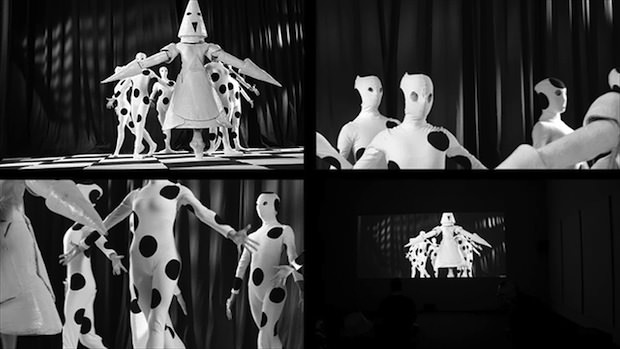
Dimensions vary with installation
WW: Does the transition into other mediums become easier with the innate nature of your storytelling?
MD: Yes, I really like that when I get tired of one medium I can go into another. It keeps the learning process going, especially if I go onto something new. Usually, when I work on film I move onto something different, like the length or the story of the dancers. It keeps everything exciting.
WW: How did theatre come into your work?
MD: When I began working with dancers, I really started appreciating ballet and stage sets. I worked with these dancers for a short piece in Winnipeg, the first time I started with performance, but I didn’t have proper dancers until the music video. The chess inspired videos happened after, when I realized I could have dancers in my work. I had a really good choreographer for the video. I’d show her moves and she would make them better, turn it into a real dance. Also, I wanted to reverse the film, but have the dancers dance backwards to have this unnatural movement. So knowing that, if you watch the video you’ll see a lot of the dances backwards.

Video on monitor, 13:55 min, black and white, sound
WW: Your style of drawing often stages grand scenarios full of detailed caricatures in an almost innocent, youthful manner, one which knows no restraint or limit. With this in mind, if you realise you’re drawings are too light in subject do you add darker characters in?
MD: Yes, sometimes, or if they start off dark, I’ll try to lighten it. However, my 3D boxes are more random, because I make the characters first and then place them in the sets. Sometimes I build the sets knowing how I want the characters, but they can be very random.
WW: There is a lot of hanging, nudity, and violence in your work that you don’t shy away from. How does this graphic side come out of you and through your work?
MD: A lot of the time it is just automatic drawing. My imagination goes to those places sometimes, I don’t know why, but I try not to keep it under. I just let it out.
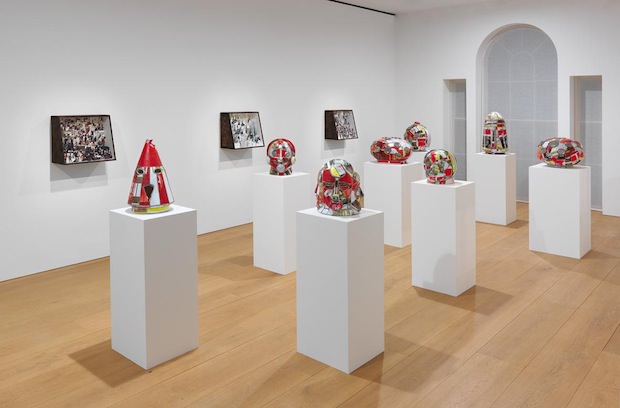
Dimensions vary with installation
WW: Your sculptures of headpieces seem as though they’re an extension of your performance work. Can you explain your references to costume, in particular with these pieces?
MD: It started with costumes because of going into film. I like the idea of having the drawings transform into life, which had to be through costume. For me making costumes lends itself to sculpture.
These particular pieces are all ceramic underneath. I was making these smaller dioramas to begin with and then, while out in Guadalajara, Mexico, I found this metals room where they built scaffolding or something, and they had all this tin material lying around. I chopped and welded the tin to create these eight headpieces, and with it are the storyboard drawings of each head. In Mexico there’s a lot of salvaged material. It was around this time my obsession with chess came about.
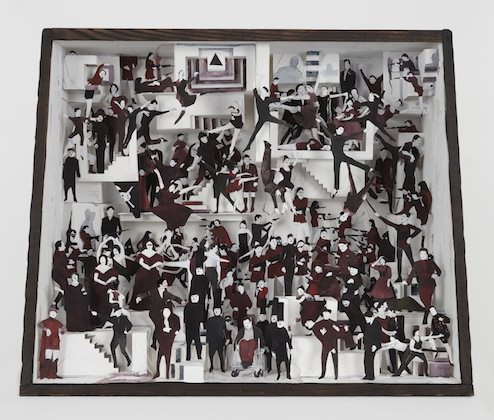
Video on monitors, 4 minutes, (loop), color, sound
WW: When did you start drawing on piano paper?
MD: It wasn’t too long ago, 2005, 2006. For my last show in London with Timothy Taylor we bought a player piano for the film that I made, and it came with this big box of piano paper. I’d never seen piano paper before, so I had this big box and thought ‘Wow I could do something with that’ and started drawing on it. I really just found and incorporated the piano paper. It’s like anything, with the tins as well.
WW: You make no attempt to hide your artistic inspiration, and in many occasions make it obvious. How did you first come across the works of Marcel Duchamp?
MD: Originally, I first heard of him because of the whole name thing being the same. Then I went to the Philadelphia museum in 2003 and saw Duchamp’s Illuminating Gas and various other things on display. After that I went to the Étant donnés and, the way it was involved in everything, I was really drawn to it. I’d seen it in textbooks but, for some reason you can’t explain, it doesn’t translate until you see it in person. That was the beginning.
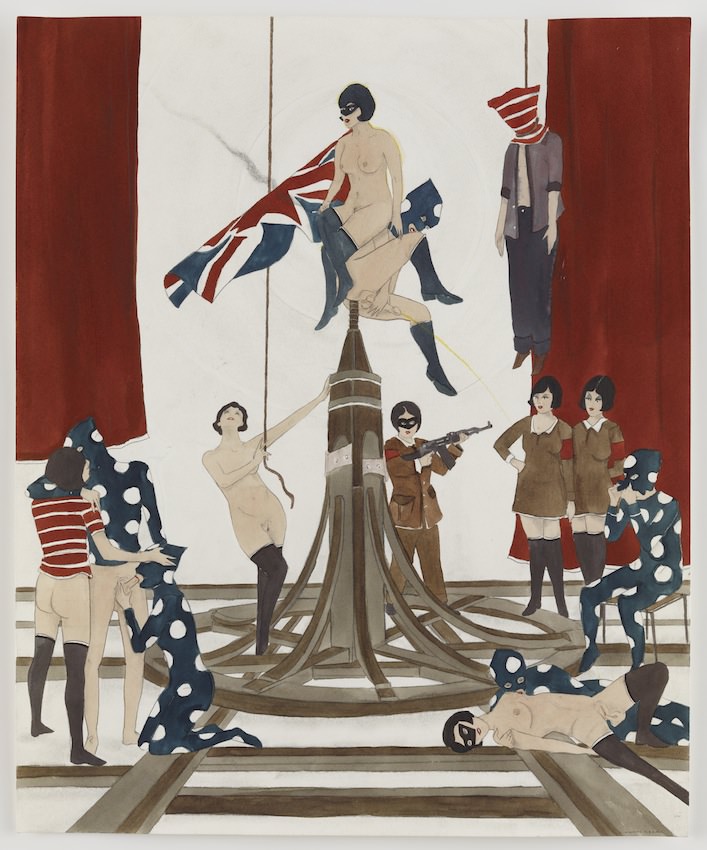
Dimensions variable with installation
Since then, I’ve read almost everything you could read about him. I’m sure that I’m missing a few of his books though. A Red Box for Marcel is a nod to Duchamp, but it could also play as being my red box. I’ve always been fond of the early Dadaist’s in Zurich and Francis Picabia. I’m always going back to Francisco Goya, and even William Blake. Blake was one of my favourite earlier artistic influences.
WW: You have close friendships with other storytelling lights such as Dave Egger and Spike Jonze; where did you first meet?
MD: Dave mentioned me in Art Forum as his favourite artist in 2001, before September 11th. I hadn’t read his book before then, and I didn’t quite know him, but I knew his work was hot. I’m always a bit behind the whole book culture thing, but my wife knew who it was immediately. From there we became friends. When Dave and Spike were working on Where The Wild Things Are, Spike mentioned that he liked my work. He actually owned some of my old work from LA. Spike rang me and we did a trade, he gave me a bunch of photographs and I gave him a couple of drawings. When I moved to New York we met again at Maurice Sendak’s retrospective and became friends after that.
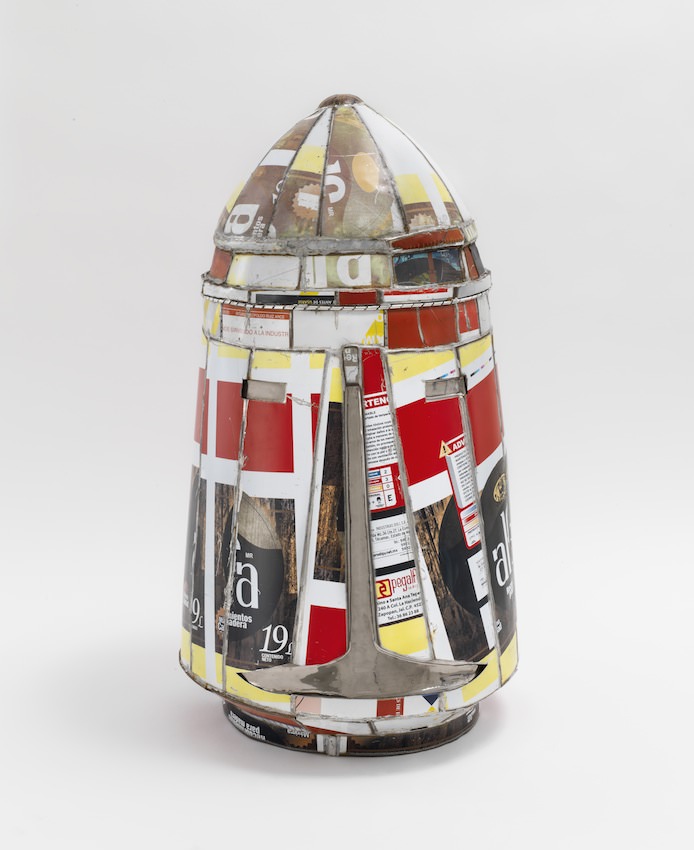
DZAMA3315_OVERALL 0000
WW: At this retrospective point, and as you grow older, do you see the themes in your work changing? For example, are many of the reoccurring characters disappearing as new ones emerge?
MD: I like the idea of a character in that by looking at them, you have some idea of who they are, and if you follow them, you’ll get the whole picture. As a kid watching all these sci-fi movies I would create my own surrealist situation; probably out of boredom, but they would develop and get more complicated with backgrounds and characters on a much bigger scale.
Current events have a huge affect on my drawing, and just being affected by what’s happening in the world affects my own ‘world.’ I made this one drawing right after the shooting in Sandy Hook, in disgust of the events, and I stopped drawing machine guns as a result of it. Also, having a baby made me look back on my life. I find some characters and themes disappear, whilst others develop; there’s a lot more breast feeding happening. I guess when you hit forty everyone has a retrospective. Time goes by very fast.
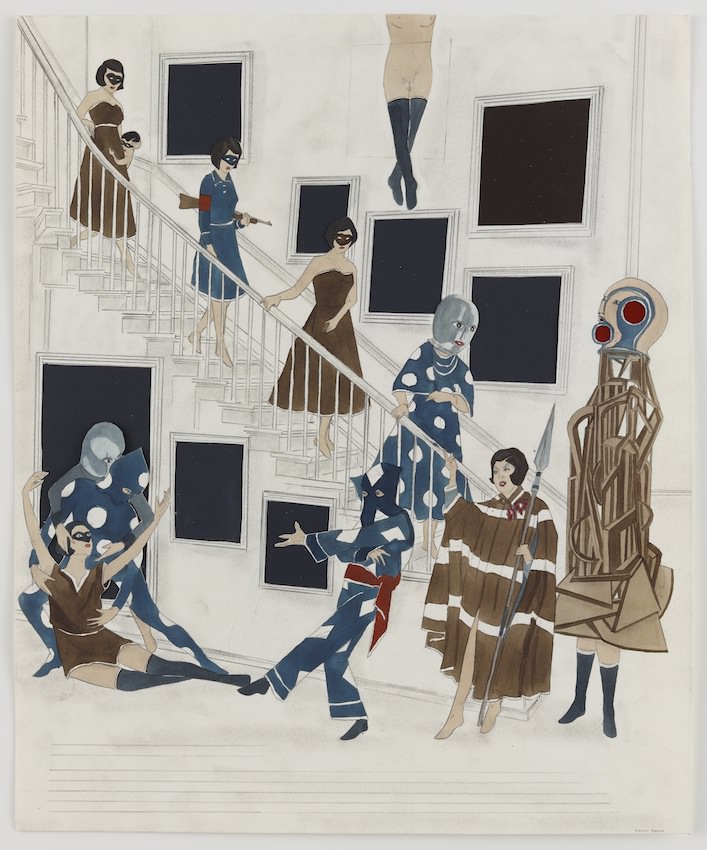
Diorama: wood, glass, cardboard, paper collage, watercolor, and ink
Marcel Dzama was born in 1974 in Winnipeg, Canada, where he received his B.F.A. from the University of Manitoba. Dzama has exhibited widely in the United States and internationally. Recent solo exhibitions include those organized by the Museo de Arte de Zapopan (MAZ), Zapopan, Mexico; World Chess Hall of Fame and Museum, St. Louis, Missouri (all 2012); Kunstverein Braunschweig, Germany (2011); Pinakothek der Moderne, Munich (2008); Ikon Gallery, Birmingham, England (2006); and Le Magasin – Centre National d’Art Contemporain de Grenoble, France (2005). Work by the artist is held in museum collections worldwide, including the Corcoran Gallery of Art, Washington, D.C.; Musée d’art contemporain de Montréal, Canada; Museum of Contemporary Art, Los Angeles; The Museum of Modern Art, New York; National Gallery of Canada, Ottawa; Solomon R. Guggenheim Museum, New York; and the Tate Gallery, London; He lives and works in Brooklyn, New York.





